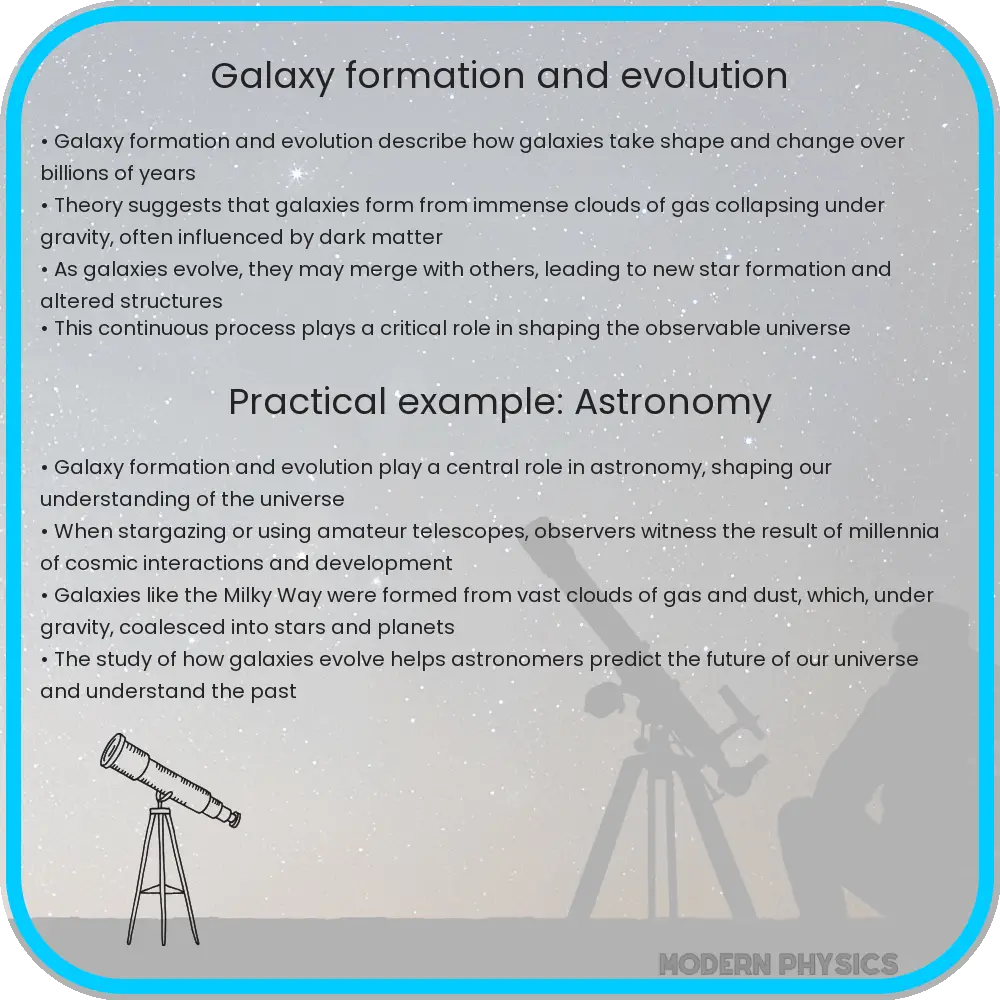Explore the fascinating journey of galaxy formation, from the early universe’s fluctuations to the complex dynamics shaping their evolution and structure today.

Understanding Galaxy Formation: A Journey Through Time and Space
The universe, a vast expanse of mystery and wonder, is home to billions of galaxies, each with their own unique structures and histories. The formation of galaxies, a fundamental question in the field of cosmology, involves complex processes that intertwine the laws of physics with the fabric of the cosmos. This article delves into the origins, dynamics, and cosmological aspects of galaxy formation, shedding light on how these colossal structures came to be.
Origins of Galaxies: The Cosmic Blueprint
The story of galaxy formation begins shortly after the Big Bang, approximately 13.8 billion years ago. In the early universe, matter was almost evenly distributed but not perfectly so. Tiny fluctuations in density, generated by quantum fluctuations during the inflationary period, served as the seeds for future galaxies. As the universe expanded and cooled, gravity began to pull these denser regions of dark matter and baryonic matter together, forming the first proto-galaxies.
Dynamics of Galaxy Formation: The Role of Dark Matter
Dark matter, though invisible and detectable only through its gravitational effects, plays a pivotal role in galaxy formation. It acts as a scaffold around which baryonic matter (the matter that makes up stars, planets, and living beings) accumulates. Over time, these areas of higher density attract more matter, leading to the formation of stars and the eventual birth of galaxies. This process, known as hierarchical clustering, sees small structures merge to form larger ones, creating the diverse range of galaxy shapes and sizes observed today.
Cosmological Influences: The Expansion of the Universe
The cosmological principle, which states that the universe is homogeneous and isotropic on large scales, influences galaxy formation. Despite this large-scale uniformity, local variations allow for the rich structure of the cosmos. The expansion of the universe affects galaxy formation by stretching the fabric of space, influencing the gravitational interactions between different structures. Additionally, cosmic background radiation provides insights into the early conditions of the universe, helping astronomers understand the initial stages of galaxy formation.
The Evolution of Galaxies: From Past to Present
As galaxies evolve, they undergo various transformative processes. Star formation, supernova explosions, and the accretion of gas play significant roles in shaping their properties and structures. Interactions and mergers between galaxies, a common occurrence in the cosmos, lead to dramatic changes in their appearance and composition. For instance, the collision of two spiral galaxies can result in the formation of an elliptical galaxy, altering the galactic landscape.
The Role of Supermassive Black Holes
At the heart of most, if not all, massive galaxies lies a supermassive black hole. These colossal entities significantly influence galaxy evolution through their energetic outputs. As matter falls into a black hole, it releases vast amounts of energy, which can regulate star formation within the galaxy. This process, known as feedback, can halt star formation by blowing away the galaxy’s gas, thereby affecting its growth and evolution.
Galactic Chemical Evolution
The chemical composition of galaxies also evolves over time. Initially composed almost entirely of hydrogen and helium, galaxies enrich with heavier elements through stellar nucleosynthesis. As stars age and die, they eject these elements into the interstellar medium, contributing to the cosmic chemical abundance. This process of chemical enrichment is crucial for the formation of planets and the emergence of life, linking galaxy evolution directly to our own existence.
Conclusion
Galaxy formation and evolution is a complex, ongoing process influenced by a myriad of factors, from the dark matter that shapes their initial structure to the supermassive black holes that can govern their future. The dynamics of galaxies are a testament to the ever-changing nature of the cosmos, reflecting a history billions of years in the making. By studying the origins, dynamics, and evolution of galaxies, astronomers can piece together the grand narrative of the universe, providing insights into the past and hints at the future. As technology advances and our understanding deepens, the story of galaxy formation continues to unfold, revealing the cosmic ballet that shapes our night sky.
